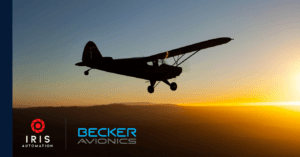 Collsion avoidance between manned and unmanned aircraft is critical. Now, Becker Avionics and drone collison avoidance developer Iris Automation to enhance general pilot aviation safety.
Collsion avoidance between manned and unmanned aircraft is critical. Now, Becker Avionics and drone collison avoidance developer Iris Automation to enhance general pilot aviation safety.
by DRONELIFE Staff Writer Ian M. Crosby
Globally-renowned aviation supplier Becker Avionics has partnered with commercial drone safety innovator Iris Automation in order to increase situational awareness of general aviation pilots and advance UAV safety. The partnership will develop a non-required safety enhancing equipment system to detect and warn pilots of nearby, potentially threatening aircraft.
The Iris Automation and Becker Avionics collision avoidance safety system relies on computer vision and machine learning to “see” approaching aircrafts from outside the pilot’s field of view that pose a risk to the equipped aircraft, issuing 3D audio warnings. The system combines Iris Automation’s Casia detect and alert technology with Becker Avionics’ communication and navigation equipment expertise for crewed and uncrewed airborne applications alike.
“This relationship is a pivotal move for Iris Automation as it defines and accelerates our work in the general aviation space,” said Jon Damush, Iris Automation’s CEO. “Our core mission is to improve air safety by avoiding collisions and this extension of our technology is a natural evolution. We are excited to be able to work with one of the most storied brands in the industry to deliver this important innovation.”
How the Collision Avoidance Systems Will Work
Many aircrafts are fitted with radio-based signalling technology (ADS-B) in order to avoid mid-air collisions. However, traditional ADS-B signals are unavailable in some airspace, increasing the workload on a pilot to monitor for incoming aircrafts. The Bureau of Transportation Statistics shows that 1450 near mid-air collisions were reported from 2016-2020. Eighty-two percent of mid-air collisions occur from the rear, according to the AOPA Air Safety Foundation (ASF). This risk is especially acute for the $48B helicopter market, with over 38,000 aircraft in service worldwide.
The Iris Automation and Becker Avionics opto-electric and audio system will monitor airspace in visual flight conditions independently, onboard the pilot’s aircraft, even if ADS-B or TCAS signals are not available. Both in the cockpit and remote, it supplements pilots’ situational awareness during instrument scans or other parts of the airspace. By warning pilots in time for them to take appropriate actions to avoid potential collisions, the system is designed to improve safety with minimal impact on pilot workload.
“Becker Avionics has provided reliable aviation equipment for 65 years, enabling regulatory compliance and aviator safety,” said Roland Becker, Chairman of Becker Avionics. “Partnering with an innovator like Iris Automation will allow our customers to exploit advanced technology to fly safer, especially as airspace congestion increases. Client interest in this kind of solution is very high, and our ability to service both their cockpit and remote pilot safety needs is unique in the industry.
 Ian attended Dominican University of California, where he received a BA in English in 2019. With a lifelong passion for writing and storytelling and a keen interest in technology, he is now contributing to DroneLife as a staff writer.
Ian attended Dominican University of California, where he received a BA in English in 2019. With a lifelong passion for writing and storytelling and a keen interest in technology, he is now contributing to DroneLife as a staff writer.
Miriam McNabb is the Editor-in-Chief of DRONELIFE and CEO of JobForDrones, a professional drone services marketplace, and a fascinated observer of the emerging drone industry and the regulatory environment for drones. Miriam has penned over 3,000 articles focused on the commercial drone space and is an international speaker and recognized figure in the industry. Miriam has a degree from the University of Chicago and over 20 years of experience in high tech sales and marketing for new technologies.
For drone industry consulting or writing, Email Miriam.
TWITTER:@spaldingbarker
Subscribe to DroneLife here.
"between" - Google News
September 18, 2021 at 09:39PM
https://ift.tt/3klrl07
Collision Avoidance Between Drones and Manned Aviation: Iris Automation and Becker Avionics - DRONELIFE - DroneLife
"between" - Google News
https://ift.tt/2WkNqP8
https://ift.tt/2WkjZfX
Bagikan Berita Ini















0 Response to "Collision Avoidance Between Drones and Manned Aviation: Iris Automation and Becker Avionics - DRONELIFE - DroneLife"
Post a Comment